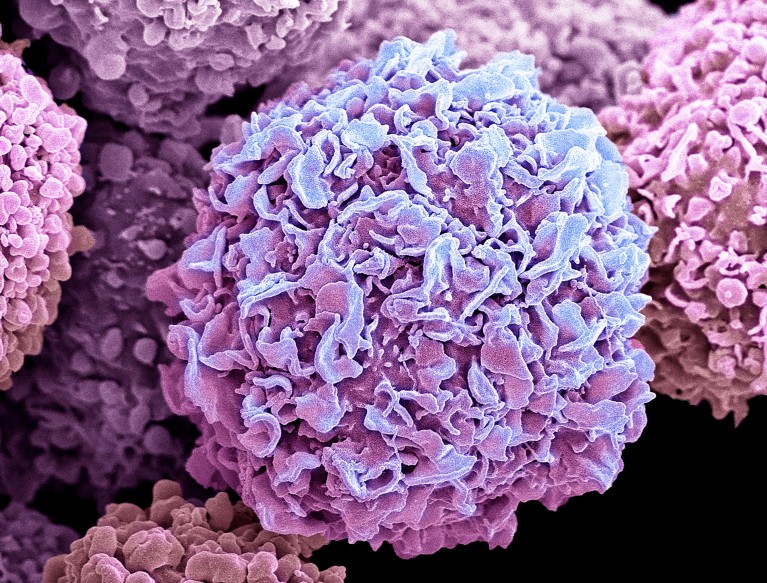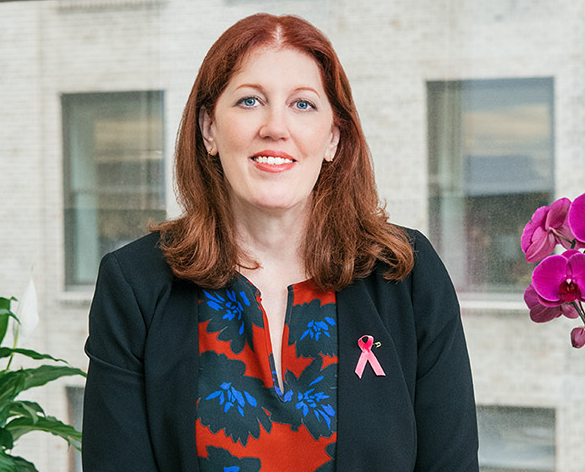
One lost year of breast cancer research funding can amount to ten years of lost research advances.Credit: Steve Gschmeissner/Science Photo Library/Getty Images
Published November 2020
The COVID-19 pandemic has impacted just about every aspect of breast cancer care. Patients and doctors have been forced to adapt to the new normal, and the Breast Cancer Research Foundation (BCRF) is no different. Dorraya El-Ashry, the Chief Scientific Officer of BCRF, explains how the foundation has navigated the crisis and is committed to data sharing.
How has the pandemic affected the BCRF research community?
Breast cancer research faces a steep cut in funding. BCRF’s researchers depend on our support to make discoveries, mount clinical trials, and keep labs in full operation. If we fall short, the impact on breast cancer research will be profound.
When social distancing measures were at their height, many labs closed and clinical trials were placed on hold. The biggest danger is not what happened over the last few months — many researchers adapted and found new ways to continue. The real danger is if research funding is diminished, it will put a stop to the progress we’ve made in the last decades, essentially an increase in preventable deaths.
With science, you can’t just turn the tap off and then turn it back on. There’s loss of lab personnel, loss of research models, labs that may need to close and data that is lost because the experiments couldn’t be finished. The consequence of decreased funding is much more long term — one year of lost funding could result in 10 years of lost advances.
Dorraya El-Ashry, Chief Scientific Officer of the Breast Cancer Research Foundation.Credit: Breast Cancer Research Foundation
After 30 years spent as a breast cancer research scientist, I had a lot of ideas for how to help steer this global, scientific endeavor to eradicate breast cancer. One area I had high hopes for was to increase investments in breast cancer disparities research. Prior to the pandemic, we were working towards that goal to secure expanded funding for this specific area of research. Now the field faces a future of diminished funding, and yet, it’s clear that this area of research is needed now more than ever as disparities in health outcomes has become a central issue in the social justice movement. My hope is that, as we come out of COVID-19 downturn, this becomes an area we can pursue with deeper investments.
What are some of your other research priorities?
There are two ends of the spectrum that we need to target: Finding curative treatments for patients living with breast cancer, and preventing breast cancer from happening in the first place. Certainly novel therapeutics and precision medicine are some of the most urgent areas—we need treatments that can prolong lives and effect cures for women with metastatic breast cancer today. And we have to be thinking about the ultimate end goal, which is to prevent breast cancer. In order to best target these two goals, we need to support an entire spectrum of research—from basic science studying the roots of the disease to clinical trials moving treatments from the lab to patients.
In 2019, BCRF partnered with Springer Nature to help make research datasets publicly accessible for papers published by npj Breast Cancer. Why undertake this pilot programme?
A key tenet of BCRF’s mission is to connect investigators around the world, and this partnership with Springer Nature is a critical tool in making that happen. We all know that submitting research results in scientific journals and presenting them at major conferences is what allows investigators to review and comment on the work of others, but what’s missing are the raw data. So, we wanted to facilitate data-sharing among researchers who publish in npj Breast Cancer by helping to make all their datasets available in an accessible way. This will help researchers validate published results and allow scientists to ask new questions, generate hypotheses, and query their data from and with these datasets.
How is BCRF different from other funders of breast cancer science?
BCRF was founded by Evelyn Lauder and Larry Norton with a vision to provide the best minds in breast cancer research with the security and freedom to pursue novel ideas. Rather than funding research projects with proven outcomes, we invite investigators with demonstrated track records in the field to submit proposals —proposals that are innovative and hold the potential to advance the field in some way, but don’t require an established result at the outset. We are in the 27th year of funding breast cancer research in this way — now supporting the scientists that have been involved in every major breast cancer research breakthrough to date.
How can you tell?
In this past year, we initiated a process of impact reviews, starting with a group of 40 investigators who have had BCRF awards for many years. And by any number of measures — publication rates, citation rates, other grant funding generated from BCRF-supported work— the impact of their work has been extremely significant. The most significant measure: the impact on patient lives over the last three decades. Breast cancer mortality rates have declined by 40 percent in that time in the U.S. Early-stage breast cancers have a five-year survival rate of over 90 percent. Nonetheless we remain committed to the women and men that continue to be diagnosed with metastatic breast cancer. And with estimates of a rise in advanced breast cancer cases as a result of delays in diagnosis and treatment during the pandemic, the research we fund today has the potential to save even more lives tomorrow.


